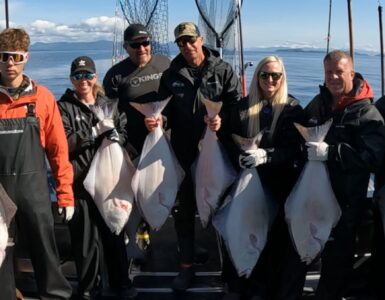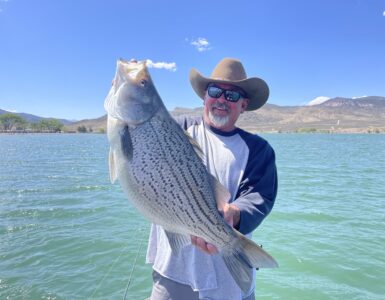Thanks for tuning into KSL Outdoors and welcome to Lake Powell. It was just a
few weeks ago that we showed you the Hand In Hand event down near the
Wahweap Marina where we got to take a few families out fishing who lost their
loved ones in the war. Tonight it’s all about fishing though. We’ve headed up
to the northern end of the lake, we are going to meet a few buddies and fish
with Mr. Lake Powell himself, Wayne Gustaveson.
I’ve been coming to Lake Powell for over 40 years. The scenery, the water, the
fishing never gets tiring and when you get a chance to fish with a legend of
Lake Powell, you don’t pass it up.
(Wanye as student gets off boat) good idea man, good idea. (wayne) anybody
else want to try the shoreline? We caught up with Wayne while he was
mentoring some BYU students.
If you fished Lake Powell the last couple of years, this year you’ll notice a
change. For starters, you won’t see some many of the big stripped bass and
the numbers of strippers that we’ve enjoyed catching the last two years.
(Wayne Gustaveson, UDWR Lake Powell Project Leader) it’s the cycle it’s the
boom and bust cycle. Last two years we had the boom, catch all you want,
careful not to overload your boat so it won’t sink. Now, over winter, some of
those really big fish that got skinny over winter, we lost those. but that’s the
natural progression in Lake Powell, as we get too many fish the big ones die.>
(Wayne) but the good point after that is now we are catching little one year
old and two year old fish and as soon as the shad spawn this year, those fish
will eat the shad. The big skinny fish aren’t there to take any of the shad away
from them. So they will grow quickly into the big fish once again, so by this
fall, after the good boils we are going to have some great two to three pounds
stripers to catch.
(Adam) if I’m looking for strippers, I can’t find them. Where other options do
I have? (wayne) we have two options, one is the bait option that we are
showing today. The other one, which I like much better is trolling.
(Wayne) so we go to the back of the canyon and you are coming up out of
deep water and you come up to a bench that is 25-30 feet deep and there is a
water color change, a really good demarcation. Then you start trolling and
shad raps or other lures that run about 10-12 feet deep trolled across that
real shallow water is very effective right now.>
Two weeks after we talked with Wayne, found us fishing and trying his
techniques up lake out of Bullfrog.
Friend of the show, Ryan Mosley, the fisheries biologist at Flaming Gorge has
found a group of hungary strippers, but not in the back of a canyon. He’s
found them on Tapestry wall, located just up lake from Knowles Canyon.
(Ryan Mosley, UDWR Fisheries biologist) We found a lot of active strippers
and really healthy strippers just pulling crank baits like these Wally Divers in
various colors. We got fish on all of these.
(Ryan Mosley) They run extremely fast, you know if you let 140 feet of line,
they run at 14 feet depth. We were marking fish about 20 feet and we were
just running over their heads. They run really true out of the box so you don’t
have to do much adjustment and they handle speed really well. We were
trolling about 3.0 to 3.5 mph and they don’t flare out at all so they are really
good crankbait for trolling especially on lake powell.
This years water at Powell is down about 7 years from last year, that’s the bad
news, the good news is Powell is expecting a great runoff this year. The Castle
Rock cut was deepened this year and is now flooded and deep enough for
boats.
(Wayne) Luckily we are going to get 40-45 feet and that’s a great runoff, we
didn’t get any snow in the winter at Page, but up lake in Colorado where we
appreciate it very much, they got a lot of snow.
Colorado’s snowpack hit one hundred and fifteen percent this year. Right now,
the lake is coming up about a foot a day.
(adam) have we been down long enough to build some tamarisk? (wayne)
we’ve got some small ones, we’ve got tamarisk that are this high and that’s
going to be helpful. If I had the button and I could control it, I would leave the
lake lower for another year, let those tamarisk get as tall you are, then cover
them up and that would help the bass and crappie much more. But this going
to be ok, they’ll be able to maintain.
Lake Powell came up over 10 feet since since the first of June Fast rising water
means fishing success along the shoreline declines as water covers new
ground. According to Wayne, the answer is to fish deeper water unaffected by
rising water and to use specialized techniques. One that works really well,
especially for walleye is called bottom bouncing.
(Adam) alright there’s another good eye, some of the best eating fish in
Utah. You know bottom bouncing isn’t a technique a lot of people use. My
buddy Brad Cutler is one of the better walleye anglers I’ve ever hung out with.
Let me give you a rundown of how to do it. I’ll get this eye into the live well
real quick.
(Adam) It’s basically a worm harness behind a two ounce bottom bouncer.
Pretty simple you get it out on the side of your boat, you need to have a
trolling motor on the front of your boat. Troll about 1.0 to 1.2 mph, really
slow, just enough so that this worn harness actually spins. I don’t know if the
color matters much, I’ve got a pearl on right now and it’s actually catching
quite a few.
The key is having a nightcrawler on the back. Pretty simple to put
on, I’ll take this one on and put it back on for you. You take it and put it on
the very tip of the night crawler and then so that they night crawler runs flat
and true and straight. You straighten him out and put the second hook in him.
Again it’s just getting this in about 10-15 feet of water, sometimes where the
waves are crashing up onto the bank is a good place because it seems to stir
up the bait fish a little bit. Walleye prefer a little bit more cloudy water as well
so here you can take a look at how that blade spins in the water.
(Adam) The walleye are hanging out right near the bottom. You feel the
bottom, you lift up just a little bit. It’s not a big bass hit or a trout hit when
you get a bite. When you get a hit, feed it to them a little bit and then you just
sweep it forward. Pretty simple.
(Adam) yup, little eye. Just lift him into the boat. Your first walleye! We
haven’t gone 30 feet! (jared) first walleye, that’s awesome.
this may be Jared’s first eye, but he was catching on quick.
(jared) we are going to be eating good. (adam) well somebody is. (jared) I’ll
let you have one of them.
(Wayne) I like to troll for them, lures that run about 10-12 feet deep pulling
across a main channel points, so that they’ll bump bottom twice as they go
across the point and you’ll be able to catch a bunch of walleye.>
(Tag toss to Fish Tech) bottom bouncing is definitely a great technique if you
are trying to catch walleye down here at Lake Powell. A great technique for
Yuba, even Utah lake, so if you want to get some walleye, some of the tastiest
fish around, make sure to give it a try.







Add comment